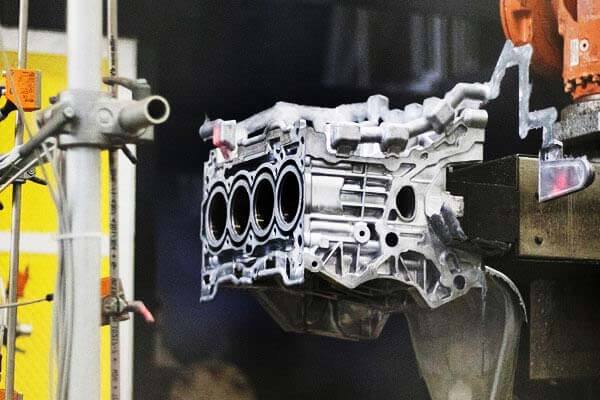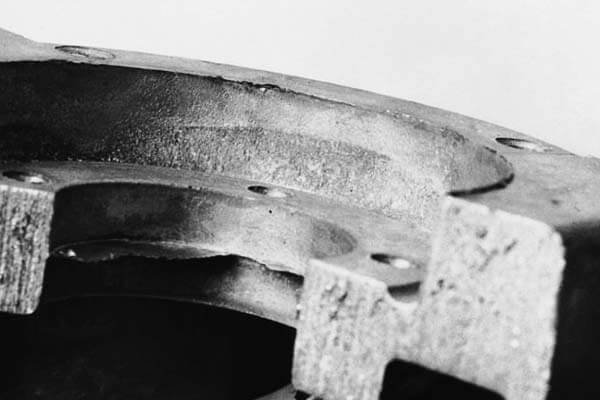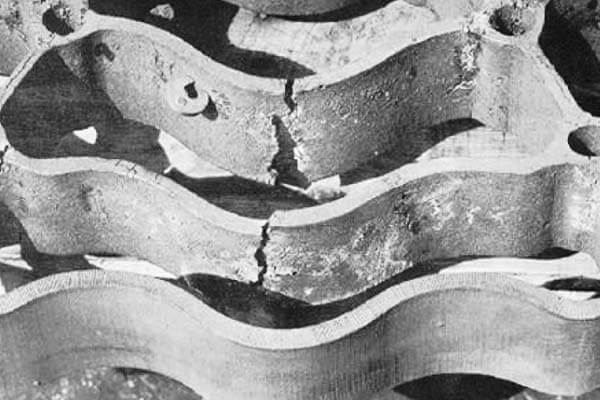1. Introduzzjoni
Die casting huwa proċess ta 'manifattura preċiż u effiċjenti ħafna użat biex jipproduċi partijiet tal-metall kumplessi.
Użat b'mod wiesa 'fl-industriji bħall-karozzi, aerospazjali, elettronika, u prodotti tal-konsumatur,
die casting joffri vantaġġi bħal rati ta 'produzzjoni għolja, preċiżjoni dimensjonali eċċezzjonali, u finituri tal-wiċċ lixxi.
Madankollu, anke fi proċess preċiż daqs die casting, difetti huma inevitabbli.
Dawn id-difetti jistgħu jikkompromettu l-kwalità tal-partijiet, li jwassal għal dewmien li jiswa ħafna flus u nuqqas ta' sodisfazzjon tal-klijenti.
Nifhmu l-aktar difetti komuni tad-die-casting, il-kawżi tagħhom, u miżuri preventivi huma essenzjali biex jinżammu standards ta' produzzjoni għoljin.
F'dan l-artikolu, aħna ser nesploraw difetti komuni tad-die-casting, kif għandhom impatt fuq il-produzzjoni, u modi effettivi biex jiġu evitati.
2. X'inhu Die Casting?
Die casting huwa proċess fejn il-metall imdewweb jiġi injettat ġo moffa taħt pressjoni għolja. Il-metall imbagħad jitkessaħ u jissolidifika f'forma preċiża.
Huwa komunement użat għall-produzzjoni ta 'partijiet b'ġeometriji kkomplikati li jeħtieġu preċiżjoni dimensjonali għolja.

Benefiċċji Ewlenin:
- Preċiżjoni: Die casting jista 'jikseb tolleranzi stretti daqs ± 0.1 mm, jagħmilha ideali għal partijiet li jeħtieġu dettall kkomplikat.
- Kosteffikaċja: Ladarba jsiru l-forom, il-proċess huwa effiċjenti ħafna u kost-effettiv, speċjalment fil-produzzjoni ta 'volum għoli runs.
- Rati ta 'produzzjoni għoljin: Die casting jista 'jipproduċi eluf ta' partijiet identiċi f'perjodu qasir, li jagħmilha popolari għall-manifattura fuq skala kbira.
Metalli Komuni Użati:
- Aluminju: Jammontaw għal kważi 85% tal-prodotti kollha die-cast, magħruf għar-reżistenza ħafifa u tal-korrużjoni tiegħu, komunement użati fl-industriji tal-karozzi u aerospazjali.
- Żingu: Joffri saħħa għolja, fluwidità kbira tal-ikkastjar, u reżistenza għall-korrużjoni. Ħafna drabi jintuża għaż-żgħar, partijiet kkomplikati.
- Manjesju: L-eħfef metall strutturali, li joffri proporzjon għoli ta 'saħħa-piż, spiss jintuża f'applikazzjonijiet aerospazjali u awtomotivi.
- Ligi tar-ram: Magħruf għal qawwa għolja u konduttività elettrika, ligi tar-ram huma użati għall-komponenti elettroniċi.
3. Difetti Komuni Die Casting
Id-difetti tad-die-casting jistgħu jkollhom impatt fuq il-kwalità tal-parti, funzjonalità, u appell estetiku.
Dawn id-difetti ġeneralment jaqgħu f'erba' kategoriji: difetti fil-wiċċ, difetti interni, difetti dimensjonali, u difetti relatati mal-materjal.
A. Difetti fil-wiċċ

- Flash
Il-flash iseħħ meta l-metall żejjed joħroġ mill-kavità tal-moffa, tipikament minħabba pressjoni tal-ikklampjar insuffiċjenti jew nuqqas ta 'qbil fil-partijiet tal-moffa.
Jirriżulta fi rqiqa, xewk tal-metall mhux mixtieqa madwar l-ikkastjar, li għandhom ikunu mirquma. - Mitfija kiesħa
Jingħalqu kiesaħ huwa r-riżultat tal-metall imdewweb li jonqos milli jingħaqad bis-sħiħ matul il-proċess tal-ikkastjar minħabba temperatura inadegwata jew fluss ħażin.
Jidher bħala ħjata jew linja fuq il-wiċċ tal-ikkastjar u jista 'jdgħajjef b'mod sinifikanti l-parti. - Marki tal-Ħruq
Il-marki tal-ħruq huma kulur skur jew akkumulazzjoni tal-karbonju fuq il-wiċċ tal-ikkastjar.
Dan huwa tipikament ikkawżat minn sħana żejda tal-metall jew espożizzjoni eċċessiva għas-sħana matul iċ-ċiklu tad-die-casting. - Porożità tal-wiċċ
Il-porożità tal-wiċċ tirriżulta f'toqob żgħar jew vojt li jidhru fuq il-wiċċ tal-ikkastjar.
Dan id-difett ħafna drabi huwa kkawżat minn arja jew gass maqbuda fil-metall imdewweb matul il-proċess ta 'injezzjoni.
B. Difetti interni

- Porożità Interna
Il-porożità interna tirreferi għall-bwiet tal-arja maqbuda ġewwa l-ikkastjar, tagħmel il-parti aktar dgħajfa u aktar suxxettibbli għal falliment taħt stress.
Dawn il-vojt spiss iseħħu meta l-gass jinqabad matul il-proċess ta 'solidifikazzjoni. - Jinxtorob
Id-difetti ta 'jinxtorob iseħħu meta l-ikkastjar jissolidifika u jikkuntratta, toħloq vojt fil-parti.
Dan huwa tipikament ikkawżat minn tkessiħ irregolari jew provvista inadegwata tal-metall imdewweb. - Tiċrit sħun
Tiċrit sħun iseħħ meta l-ikkastjar jinqasam waqt it-tkessiħ, ħafna drabi f'sezzjonijiet b'ħitan irqaq fejn l-istress waqt is-solidifikazzjoni jaqbeż il-kapaċità tal-materjal li jirreżisti.
Ċ. Difetti Dimensjonali
- Warpage
Il-warpage iseħħ meta l-partijiet jiddeformaw minħabba tkessiħ irregolari jew tensjonijiet interni residwi.
Dan huwa partikolarment komuni f'partijiet kbar jew kumplessi fejn ir-rati tat-tkessiħ ivarjaw f'taqsimiet differenti. - Allinjament ħażin
L-allinjament ħażin iseħħ meta n-nofsijiet tal-moffa ma jallinjawx sew, li tikkawża żbalji fil-ġeometrija parzjali.
Dan jista 'jkun ikkawżat minn disinn fqir tal-moffa jew ikklampjar mhux xieraq waqt l-injezzjoni. - Dimensjonijiet mhux eżatti
Kundizzjonijiet inkonsistenti tal-iffurmar, bħal pressjoni jew temperatura mhux xierqa, jista 'jirriżulta f'partijiet li ma jissodisfawx l-ispeċifikazzjonijiet tad-disinn.
D. Materjal Die Casting Difetti
Id-difetti relatati mal-materjal huma kkawżati minn impuritajiet, kontaminazzjoni, jew immaniġġjar ħażin tal-materjal.
Dawn id-difetti jistgħu jirriżultaw f'imperfezzjonijiet tal-wiċċ, porożità, u anke falliment parti.
4. Kawżi ta' Difetti ta' Die Casting
Id-difetti tad-die-casting jistgħu jinqalgħu minn diversi fatturi matul il-proċess tal-produzzjoni.
Il-fehim ta' dawn il-kawżi huwa kruċjali biex jiġi identifikat l-għerq tal-problema u jittieħdu azzjonijiet korrettivi.
Hawn taħt jinsabu l-kawżi ewlenin tad-difetti tad-die-casting:
Kwistjonijiet Relatati mal-Materjal
- Impuritajiet: Kontaminanti jew impuritajiet fil-metall, bħal ossidi jew ħmieġ, jistgħu jikkompromettu l-kwalità tal-ikkastjar.
Materjali impuri jistgħu jirriżultaw f'difetti bħal porożità jew għeluq kiesaħ. - Kontenut ta' Umdità: Umdità eċċessiva fil-metall jew moffa tista 'tikkawża fwar li jifforma matul il-proċess ta' injezzjoni.
Dan jista 'jwassal għal bżieżaq, bwiet tal-gass, u difetti bħal porożità jew pitting tal-wiċċ. - Kompożizzjoni tal-liga: Jekk il-liga tal-metall ma titħallatx sew jew għandha l-kompożizzjoni ħażina għall-proprjetajiet mixtieqa, jista 'jikkawża jinxtorob jew porożità interna.
Miżura preventiva: Uża ta 'kwalità għolja, nadif, u materjali ppreparati tajjeb, u l-iżgurar li l-metall huwa msaħħan minn qabel u mmaniġġjat b'mod korrett jista 'jnaqqas dawn il-kwistjonijiet.
Disinn u Kundizzjoni tal-Moffa
- Venting inadegwat: Il-ventilazzjoni xierqa hija essenzjali biex tħalli l-arja maqbuda toħroġ waqt il-proċess tal-injezzjoni.
Venting insuffiċjenti jista' jwassal għal qbid tal-gass, jikkawżaw difetti bħal porożità jew marki tal-ħruq. - Ilbes u kedd tal-moffa: Maż-żmien, forom jistgħu jintlibsu jew isofru minn allinjamenti ħażin, li jwasslu għal difetti bħal flash jew dimensjonijiet mhux preċiżi.
- Sistemi ta' Gting u Tmigħ mhux xierqa: Jekk is-sistema tal-gating tal-moffa hija ddisinjata jew imqiegħda ħażin,
jista 'jikkawża fluss tal-metall irregolari, li jwassal għal difetti bħal għeluq kiesaħ, allinjament ħażin, jew imla mhux kompluta.
Miżura preventiva: Manutenzjoni regolari tal-forom, ottimizzazzjoni ta' sistemi ta' ventilazzjoni, u t-tfassil bir-reqqa ta 'sistemi ta' gating u tmigħ jistgħu jipprevjenu dawn il-kwistjonijiet.
Parametri tal-Proċess
- Kontroll tat-temperatura: Iż-żamma ta 'temperatura konsistenti kemm għall-metall kif ukoll għall-moffa hija kruċjali.
Jekk il-metall ikun sħun wisq jew kiesaħ wisq, jista 'jwassal għal difetti bħal marki tal-ħruq, għeluq kiesaħ, jew porożità.
Bl-istess mod, temperatura tal-moffa inkonsistenti tista 'tikkawża warpage jew ineżattezzi dimensjonali. - Veloċità u Pressjoni tal-Injezzjoni: Veloċità jew pressjoni ta 'injezzjoni insuffiċjenti jistgħu jirriżultaw f'mili mhux komplut tal-moffa, li jwassal għal għeluq kiesaħ jew kkastjar mhux komplut.
Bil-maqlub, pressjoni eċċessiva tista 'tikkawża flash u ħela ta' materjal. - Rati tat-tkessiħ: Ir-rati tat-tkessiħ li huma mgħaġġla wisq jew bil-mod wisq jistgħu jikkawżaw tnaqqis, warpage, jew tiċrit sħun. Tkessiħ irregolari jista 'jwassal għal tensjonijiet interni u distorsjonijiet.
Miżura preventiva: Monitoraġġ u aġġustament regolari tat-temperatura, pressjoni, u r-rati tat-tkessiħ jiżguraw kwalità tal-produzzjoni konsistenti.
Magni u Fatturi tal-Għodda
- Imut jintlibes: Maż-żmien, l-imut użat għad-die casting jistgħu jintlibsu, iwasslu għal difetti bħal flash jew ineżattezzi fid-dimensjonijiet tal-parti.
Imut jintlibsu wkoll joħolqu distribuzzjoni irregolari tal-pressjoni, li jistgħu jirriżultaw f'difetti. - Ħsara fil-Magni: Magni die-casting difettużi jew kalibrati ħażin jistgħu jikkontribwixxu għal pressjoni inkonsistenti,
temperatura, u veloċità matul il-proċess ta 'injezzjoni, li jwassal għal difetti. - Settings Żbaljati tal-Magni: L-użu ta 'settings mhux korretti għall-magna tal-ikkastjar tad-die, bħal veloċità jew pressjoni ta 'injezzjoni mhux xierqa,
jista 'jikkawża kwistjonijiet bħal għeluq kiesaħ, imla fqir, jew flash eċċessiv.
Miżura preventiva: L-iżgurar li l-magni jiġu kkalibrati regolarment, imut huma sostitwiti jew miżmuma, u l-issettjar tal-magni huma ottimizzati jistgħu jipprevjenu dawn it-tipi ta 'difetti.
Żbalji tal-Operatur
- Immaniġġjar mhux xieraq: Operaturi li mhumiex imħarrġa b'mod adegwat jew jonqsu milli jsegwu proċeduri korretti jistgħu jagħmlu żbalji li jwasslu għal difetti,
bħal tagħbija mhux xierqa tal-moffa jew temperatura tal-metall inkonsistenti. - Spezzjoni Inadegwata: Jekk l-operaturi jonqsu milli jiskopru sinjali bikrija ta 'difetti jew ma jsegwux proċeduri xierqa ta' kontroll tal-kwalità,
difetti jistgħu jgħaddu inosservati, li jwassal għal problemi akbar aktar tard fil-produzzjoni. - Nuqqas ta' Azzjoni Korrettiva: F’xi każijiet, l-operaturi jistgħu jonqsu milli jaġġustaw il-parametri tal-proċess meta jibdew jidhru d-difetti, jippermettu li l-kwistjonijiet imorru għall-agħar.
Miżura preventiva: Taħriġ u ċertifikazzjoni xierqa tal-operaturi, flimkien ma 'proċessi ta' spezzjoni diliġenti, huma kritiċi għall-prevenzjoni tal-iżbalji u ż-żamma tal-kontroll tal-kwalità.
Fatturi Ambjentali
- Varjazzjonijiet ta 'Umdità u Temperatura: Varjazzjonijiet fl-umdità ambjentali u fit-temperatura jistgħu jaffettwaw il-fluss tal-metall u l-proċess tat-tkessiħ tal-moffa,
li jwassal għal riżultati inkonsistenti u difetti bħal porożità jew warpage. - Indafa: Trab, ħmieġ, jew materjali barranin fl-ambjent tal-produzzjoni jistgħu jikkontaminaw il-metall jew forom,
iwasslu għal difetti bħal pitting tal-wiċċ jew finitura ħażina tal-wiċċ.
Miżura preventiva: Żamma kkontrollata, ambjent nadif b'kundizzjonijiet ta 'temperatura u umdità stabbli jistgħu jgħinu biex jittaffew dawn ir-riskji.
5. Soluzzjonijiet Komuni għad-Difetti tad-Die Casting
L-indirizzar tad-difetti tad-die-casting jeħtieġ approċċ immirat li jqis il-kawżi ewlenin ta 'kull kwistjoni.
Hawn, aħna niddeskrivu soluzzjonijiet speċifiċi għal difetti komuni, appoġġjat minn dejta u għarfien prattiku biex jgħin lill-manifatturi jtejbu l-proċessi tagħhom.

Flash
Soluzzjoni: L-aġġustament tal-pressjoni tal-ikklampjar tad-die, titjib tad-disinn tal-moffa, u l-iżgurar ta 'venting xieraq huma strateġiji effettivi biex jimminimizzaw il-flash.
- Pressjoni tal-Kklampjar tad-Die: Iż-żieda tal-forza tal-ikklampjar tista 'tnaqqas l-okkorrenza ta' flash sa 25%.
L-iżgurar li n-nofsijiet tal-moffa jkunu ssiġillati sewwa jipprevjeni l-metall imdewweb milli jaħrab f'żoni mhux mixtieqa. - Disinn tal-Moffa: L-inkorporazzjoni ta 'tolleranzi aktar stretti fid-disinn tal-moffa tista' tnaqqas il-flash b'kemm 40%.
Dan jinvolvi makkinar preċiż u kontrolli ta 'manutenzjoni regolari biex jiġi żgurat li ma jkunx hemm vojt bejn is-sezzjonijiet tal-moffa. - Venting: Venting adegwat jippermetti li l-arja taħrab mill-kavità tal-moffa mingħajr ma tħalli l-metall imdewweb isegwi.
It-tqegħid tal-vent kif suppost jista 'jnaqqas il-formazzjoni tal-flash sa 30%.
Mitfija kiesħa
Soluzzjoni: Iż-żieda fit-temperatura tal-metall jew l-aġġustament tal-veloċità tal-injezzjoni tiżgura mili sħiħ tal-moffa u fużjoni xierqa ta 'flussi tal-metall.
- Temperatura tal-metall: Iż-żieda fit-temperatura tal-metall imdewweb b'10-20 °C tista 'ttejjeb il-fluwidità u tevita kwistjonijiet ta' għeluq kiesaħ.
Temperaturi ogħla jistgħu jżidu l-probabbiltà ta 'fużjoni b'suċċess sa 35%. - Veloċità ta 'l-injezzjoni: L-ottimizzazzjoni tal-veloċità tal-injezzjoni tista 'ttejjeb il-proċess tal-mili, li jwassal għal tnaqqis fid-difetti tal-għeluq tal-kesħa b'madwar 40%.
Veloċitajiet ta 'injezzjoni aktar mgħaġġla jistgħu jgħinu biex jiżguraw li l-partijiet kollha tal-moffa jimtlew qabel ma l-metall jibda jissolidifika.
Marki tal-Ħruq
Soluzzjoni: It-tnaqqis tat-temperatura tal-moffa u l-ottimizzazzjoni taċ-ċiklu tal-ikkastjar jistgħu jipprevjenu sħana żejda u marki ta 'ħruq sussegwenti.
- Kontroll tat-Temperatura tal-Moffa: It-tnaqqis tat-temperatura tal-moffa b'10-15 °C jista 'jnaqqas b'mod sinifikanti r-riskju ta' marki tal-ħruq.
Tkessiħ ikkontrollat jista 'wkoll jipprevjeni xokk termali u difetti fil-wiċċ relatati. - Ottimizzazzjoni taċ-Ċiklu tal-Ikkastjar: Is-simplifikazzjoni taċ-ċiklu tal-ikkastjar biex tiġi evitata espożizzjoni fit-tul għas-sħana tista 'tnaqqas il-marki tal-ħruq sa 20%.
Ġestjoni effiċjenti taċ-ċiklu tiżgura kwalità konsistenti tal-parti.
Porożità (Wiċċ u Intern)
Soluzzjoni: Il-kontroll tar-rata tat-tkessiħ u l-applikazzjoni ta 'tekniki ta' degassing jistgħu jtaffu kwistjonijiet ta 'porożità.
- Ġestjoni tar-Rata tat-Tkessiħ: L-implimentazzjoni ta' rati ta' tkessiħ ikkontrollati tista' tnaqqas il-porożità interna sa 30%.
It-tkessiħ gradwali jgħin biex jinħela l-gassijiet maqbuda b'mod aktar effettiv, li jirriżulta f'ikkastjar aktar dens. - Tekniki ta' Degassing: L-użu ta' metodi bħall-ikkastjar assistit bil-vakwu jew iż-żieda ta' aġenti tad-degass jistgħu jeliminaw sa 90% ta' difetti relatati mal-porożità.
Dawn it-tekniki jippromwovu t-tneħħija tal-gassijiet maħlula mill-metall imdewweb qabel is-solidifikazzjoni.
Jinxtorob u Tiċrit sħun
Soluzzjoni: L-ottimizzazzjoni tar-rati tat-tkessiħ u ż-żieda ta 'risers jistgħu jindirizzaw kavitajiet li jinxtorob u tiċrit sħun.
- Ottimizzazzjoni tar-rata tat-tkessiħ: L-irfinar tal-proċess tat-tkessiħ biex jiżgura solidifikazzjoni uniformi jista 'jnaqqas id-difetti li jinxtorob sa 20%.
It-tkessiħ uniformi jimminimizza l-konċentrazzjonijiet tal-istress li jwasslu għal tiċrit sħun. - Risers u Feeders: It-tqegħid strateġiku ta 'risers jista' jipprovdi metall imdewweb addizzjonali biex jikkumpensa għat-tnaqqis, it-tnaqqis tar-rati tad-difetti sa 35%.
Sistemi ta 'tmigħ xierqa jiżguraw li żoni kritiċi jibqgħu ħielsa minn vojt matul is-solidifikazzjoni.
Warpage
Soluzzjoni: Il-ġestjoni tar-rati tat-tkessiħ u l-minimizzazzjoni tal-istress interni jistgħu jipprevjenu warpage.
- Tkessiħ Uniformi: L-użu ta 'kanali ta' tkessiħ li jippromwovu tkessiħ uniformi jista 'jnaqqas il-warpage sa 25%.
Tkessiħ uniformi jimminimizza kontrazzjoni differenzjali u stress intern. - Stress Intern Relief: L-inkorporazzjoni ta 'trattamenti ta' ħelsien mill-istress bħall-ittemprar jista 'jnaqqas il-warpage sa 40%.
It-tnaqqis tal-istress residwu jiżgura stabbiltà dimensjonali u integrità funzjonali.
Allinjament ħażin
Soluzzjoni: It-titjib tal-eżattezza tad-disinn tal-moffa u t-titjib tas-sistemi ta 'gating jistgħu jsolvu kwistjonijiet ta' allinjament ħażin.
- Disinn ta 'Moffa ta' Preċiżjoni: L-użu ta 'teknoloġiji CAD/CAM avvanzati jista' jtejjeb l-eżattezza tal-moffa, jitnaqqsu l-iżbalji ta' allinjament ħażin sa 50%.
Forom preċiżi jiżguraw replikazzjoni preċiża tal-parti. - Gating System Ottimizzazzjoni: Id-disinn ta 'sistemi ta' gating effiċjenti li jidderieġu l-fluss tal-metall imdewweb b'mod preċiż jista 'jnaqqas l-allinjament ħażin sa 30%.
Gting xieraq jippromwovi mili bla xkiel u jimminimizza l-ispostament.
Dimensjonijiet mhux eżatti
Soluzzjoni: Kondizzjonijiet konsistenti tal-iffurmar u miżuri robusti ta 'kontroll tal-kwalità jistgħu jiżguraw dimensjonijiet preċiżi.
- Kundizzjonijiet Konsistenti tal-iffurmar: Iż-żamma ta 'parametri ta' proċess stabbli bħat-temperatura, pressjoni,
u r-rati tat-tkessiħ jistgħu jiksbu preċiżjoni dimensjonali fi ħdan tolleranzi stretti, tnaqqas il-varjabbiltà sa 20%. - Kontroll tal-kwalità: L-implimentazzjoni ta 'protokolli ta' spezzjoni rigorużi tista 'tidentifika u tikkoreġi ineżattezzi dimensjonali kmieni fiċ-ċiklu tal-produzzjoni.
Kontroll effettiv tal-kwalità jista 'jbaxxi r-rati ta' rifjut sa 15%.
6. Impatt tad-Difetti tad-Die Casting fuq il-Produzzjoni u l-Ispejjeż
- Żieda fir-Rati Ruttam: Rati ogħla ta 'ruttam iżidu l-ispejjeż tal-materjal u tal-produzzjoni.
Kull żieda ta 'punt perċentwali fir-rata ta' ruttam tista 'żżid 5% għall-ispejjeż tal-produzzjoni. - Skedi tal-Produzzjoni Estiżi: Dewmien minħabba difetti jista' jestendi l-iskedi ta' żmien u jħarbat l-iskedi.
Id-dewmien fil-produzzjoni jista' jiswa lill-kumpaniji medja ta' $10,000 kuljum. - Kontroll tal-Kwalità u Ħidma mill-ġdid: L-ispiża ta 'xogħol mill-ġdid partijiet difettużi jew skrappjar għal kollox tammonta.
Miżuri ta 'kontroll tal-kwalità jistgħu jammontaw għal sa 15% tal-ispejjeż totali tal-manifattura. - Sodisfazzjon tal-Klijent: Ikkastjar ta 'kwalità fqira jista' jnaqqas il-prestazzjoni tal-prodott u l-fiduċja tal-klijent.
In-nuqqas ta' sodisfazzjon tal-klijent jista' jwassal għal telf ta' negozju, bi studji li juru li 80% tal-klijenti mhux se jirritornaw wara esperjenza negattiva.
7. Kif tipprevjeni difetti ta 'Die Casting
Ottimizzazzjoni tad-Disinn tal-Moffa:
Disinn xieraq tal-moffa huwa kritiku biex jitnaqqsu d-difetti. Uża sistemi ta' ventilazzjoni korretti, aġġusta gating għal fluss tal-metall xieraq,
u tiżgura allinjament preċiż tal-moffa biex tnaqqas ir-riskju ta 'flash u porożità.
Kontroll tal-Parametri tal-Proċess:
Iż-żamma ta' temperatura konsistenti, pressjoni, u r-rati tat-tkessiħ jiżguraw li l-metall imdewweb jimla l-moffa kif suppost u jissolidifika mingħajr difetti.
Għażla u Immaniġġjar tal-Materjal:
Uża ta 'kwalità għolja, materjali msaħħna minn qabel inaqqas il-kontaminazzjoni u d-difetti. Il-ħażna u l-immaniġġjar xierqa huma wkoll essenzjali biex jiġu evitati kwistjonijiet relatati mal-umdità.
Għodda mtejba u Manutenzjoni tat-Tagħmir:
Manutenzjoni regolari u kalibrazzjoni ta' dies, magni, u l-għodda jgħinu biex jiżguraw kwalità konsistenti u jnaqqsu d-difetti.
Taħriġ u Kompetenza:
Operaturi mħarrġa sew huma essenzjali biex jinstabu difetti potenzjali kmieni u jieħdu azzjonijiet korrettivi fil-pront.
Għandhom jifhmu l-intricacies tal-proċess u jkunu jafu kif jaġġustaw il-parametri kif meħtieġ.
8. Konklużjoni
Die casting jibqa 'proċess ta' manifattura indispensabbli, madankollu tiġi flimkien ma' sfidi inerenti li jridu jiġu indirizzati biex jinkisbu l-aħjar riżultati.
Billi tifhem it-tipi ta 'difetti, jidentifikaw il-kawżi tagħhom, u l-implimentazzjoni ta' miżuri preventivi,
il-manifatturi jistgħu jtejbu b'mod sinifikanti l-kwalità u l-konsistenza tal-prodotti tagħhom.
Investiment f'teknoloġiji avvanzati, ottimizzazzjoni tal-proċessi, u l-iżgurar ta 'taħriġ ta' l-operatur huma essenzjali biex jimminimizzaw id-difetti u jiżguraw bla xkiel operazzjoni ta' die-casting.
Imsieħeb ma 'DEZE biex Tevita l-iżvantaġġi tad-Die Casting fil-Fabbrikazzjoni Tiegħek
Billi tissieħeb ma' DIN, ikollok aċċess għal esperjenza u soluzzjonijiet avvanzati li jgħinuk tevita d-difetti u ttejjeb il-proċess tal-manifattura tiegħek.
Jekk għandek bżonn die castings sempliċi jew kumplessi, aħna niżguraw li l-partijiet tiegħek huma ħielsa mid-difetti, tiffranka l-ħin, flus, u riżorsi fit-tul.
Ħalli DEZE tkun il-manifattur fdat tiegħek tad-die-casting, u flimkien, aħna se nieħdu l-proġetti ta 'fabbrikazzjoni tiegħek għal-livell li jmiss, ħielsa mill-isfidi tipiċi tal-manifattura.
Ikseb illum biex titgħallem kif nistgħu ngħinuk tirnexxi fil-proġett tad-die-casting tiegħek li jmiss.



